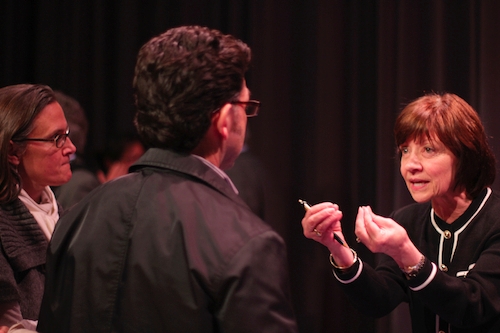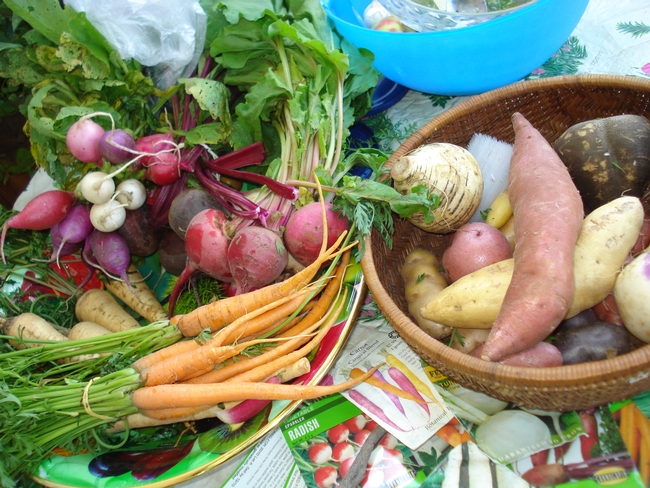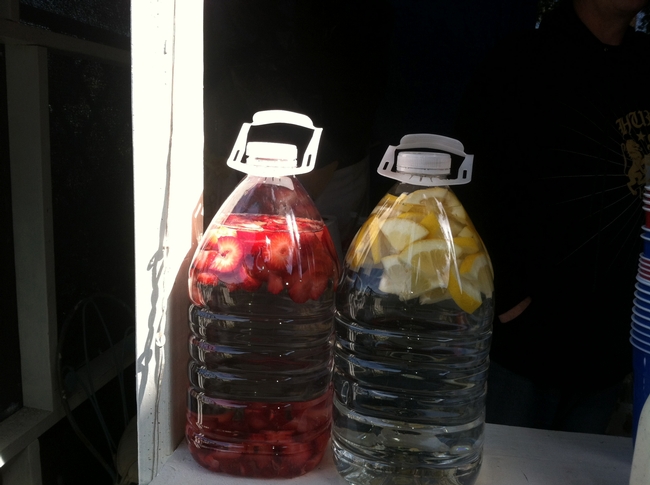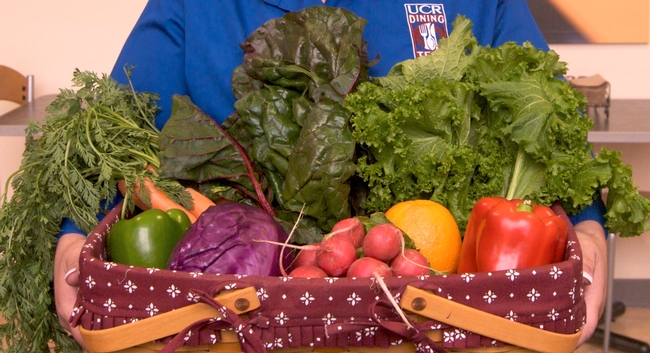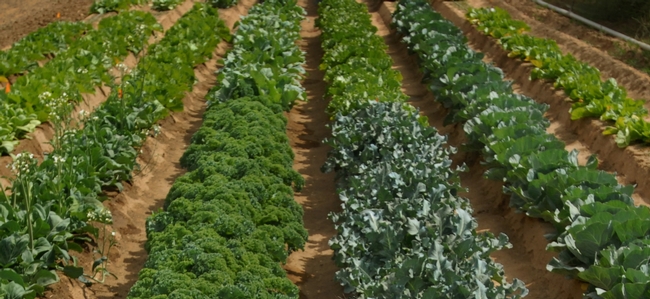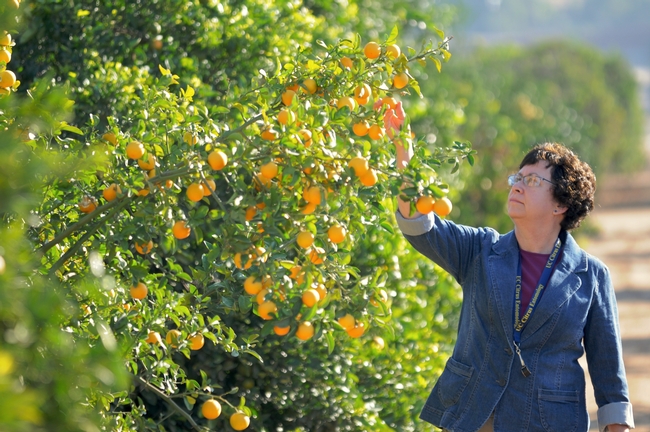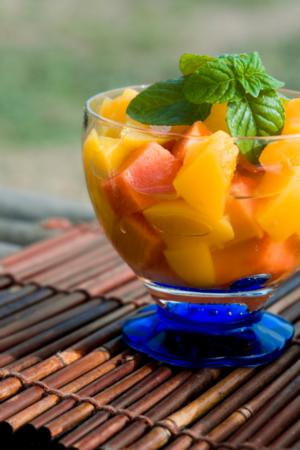UC Food Blog
The U.S. Farm Bill: What's at stake?
The United States farm bill is up for renewal this year, and what goes into the $400 billion, 5,000-plus page piece of legislation will affect what tens of millions of Americans eat — and don’t eat — in the coming years. On April 5, UC Berkeley’s College of Natural Resources fired off an enlightening salvo in the public discourse, with a panel of heavy hitters calling on the public to let their voices be heard in the quest to, as panelist Karen Ross, Secretary of the California Department of Food and Agriculture, put it, “move farmers and eaters closer together.”
Looking at the bill’s history, it’s not surprising the two groups have been driven apart. The farm bill was implemented during the Great Depression in the 1930s in order to raise commodity prices and farmers’ incomes, said Gordon Rausser, UC Berkeley professor of agricultural and resource economics and the event’s moderator. The commodities it focused on — food grains, feed grains, dairy, tobacco and peanuts — became political powerhouses while much of the food on our dinner tables — fruits, vegetables, and nuts — were relegated to the category of “specialty crops.”
Broccoli and oranges … specialty crops? “That’s what we grow here in California,” Ross said. And that's what's on the U.S. Department of Agriculture’s food plate. In the past 15 years such growers have been taking a more active role in the farm bill to make sure they are not marginalized, she said.
Over eight decades the bill has morphed from a farm to a food bill, the panelists said. Seventy-seven percent of the bill now goes to support the federal Supplemental Nutritional Assistance Program (SNAP), the reinvention of the food stamps program.
Ken Hecht, just retired from his position as the director of the California Food Policy Advocates, reeled off some facts about the people who use SNAP:
- 50 percent are working households
- 93 percent are below the poverty level
- 50 percent of benefit recipients are children
- 75 percent are households with children
“There are 1.3 million children who are getting enough to eat because of this program,” Hecht said. “It avoids all those consequences of food insecurity that we all know about: lack of adequate nutrition, lack of adequate health, lack of academic opportunity and performance, lack of social development.” The program not only helps its participants, Hecht, said, but the rest of the people in the community as well.
In addition to SNAP, support for sustainable agriculture emerged as a theme of the presentation. For insight, In Defense of Food author and UC Berkeley journalism professor Michael Pollan offered the audience the perspective of a Martian: we Earthlings are now eating oil instead of eating sunlight. What he referred to as the “free lunch of photosynthesis” was swapped out, starting in the 1940s, for high-yield, industrialized farming that relies on pesticides, machines and giant feed-lots for animals. Pollan said that while farmers were enormously successful in achieving productivity goals, the environmental costs make agriculture second only to cars in fossil fuel production, and the producer of 20 to 30 percent of the country’s greenhouse gases. He recommends a simple criteria should be applied to every provision of the farm bill, from farmers market support to the SNAP program to obscure payment structures: “The question we should ask ourselves is, is this pushing agriculture back onto the sun or is it leaving it on the fossil fuel basis?” he said. “That’s the standard I think we need to apply.”
Ken Cook, president and co-founder of the Environmental Working Group, framed the issue in terms of dollars. “One cotton farmer in 2004 received $2 million. That’s the same amount of money we spent for the entire federal program devoted to organic agricultural research,” he said.
He emphasized the connection between good food practices and good environmental practices, and called SNAP EWG’s number one priority. “We’re trying to inject healthy eating into the farm bill as a legitimate concern of public policy,” he said. He cited a pilot healthy-snack program, in which evaluators noted students who had never seen a pineapple or celery or carrots before. “We should be spending billions of dollars on this program ... getting kids hooked on fruits and vegetables."
Cook pointed out that that much of what drives the farm bill is the politics of committee members securing subsidies for their home states, and conjured the specter of the recent pink-slime debacle to show how effective a little activism can be. Fail to get involved at your peril, Cook, said. “I guarantee you will get more of the same or worse.”
Pollan passed along advice from one of Cook’s staffers: “Simply calling your representative and saying you want more healthy food, you want more environmentally sustainable food, is all you need to do.”
The event was a presentation of the UC Berkeley College of Natural Resource's Spring 2012 Horace Albright Lecture in Conservation. Watch an hour and a half video of the presentations and Q&A:
$25 million program aims to make food production less risky
Agriculture has always been a precarious enterprise, vulnerable to weather, pests, disease and fickle markets. But for the farmers and ranchers in developing nations, such inherent uncertainty becomes a matter not just of success or failure but also of life or death.
Aiming to diminish that risk and alleviate global poverty and hunger, the US Agency for International Development (USAID) has established a $25 million grant program, directed by a UC Davis agricultural economist. The program will develop and test financial systems that can boost agricultural productivity and food security in developing countries.
The five-year project will finance research projects that design and test financial technologies, such as linked credit and insurance contracts, that reduce the vulnerability of poor households to adverse events, making it easier for them to invest in new agricultural technologies and break the cycle of poverty.
“Many developing country farmers are mired in low levels of agricultural productivity, and new seeds and markets by themselves can go only so far in solving the problem,” said Michael Carter, a professor of agricultural and resource economics and director of the newly funded BASIS Assets and Market Access Collaborative Research Support Program at UC Davis.
“Closing that productivity gap now requires that we address financial, risk-management and asset constraints that are hindering poor, rural households,” Carter said. “In a world in which more than one billion people suffer from chronic hunger, this is one research effort in which failure is not an option.”
An authority on development economics and poverty dynamics, Carter has focused his recent research on agricultural risk management and the economics of sustainable food security. While on faculty at the University of Wisconsin, Madison, he managed two five-year USAID-funded research programs.
The newly funded UC Davis-based program is designed to work with other research partners worldwide and will soon put out a first call for research proposals to implement its ambitious agendas.
Index-based insurance protects against risks shared by an entire community. In this case, the index, or statistical measure of risk, is the availability of forage based on satellite imagery. When the forage index predicts livestock mortality in excess of 15 percent, an insurance payment is triggered to all clients within the defined geographic area.
Planting the seeds of good health in a North Hollywood shelter garden
Last Friday I had the opportunity to speak to a group of residents at the LA Family Housing, Valley Shelter in North Hollywood. We met outdoors amidst sprouting tomato plants, low-hanging loquats and variety of fruits and vegetables being grown in a beautiful garden setting.
It was not my first time visiting this tranquil North Hollywood shelter garden. I have come several times before to talk to the residents about nutrition, health and the importance of making smart food choices on a limited budget. I was due to return this spring to speak to the new residents who arrived since my last visit.
A Model of Success
This garden is not only producing an abundance of food for the residents of the shelter and the surrounding community, it has also served as a model of success for our UC CalFresh/ UC Master Gardener collaboration. Two highly motivated Master Gardener volunteers, Laurie Liles and Bettina Gatti, and an on-site garden manager, Richard Arpad, have regularly delivered UC CalFresh “Fresh from the Garden” lessons at this site for the past two years. The lessons have been well received by the shelter residents, many of whom enjoy the calming, therapeutic effect of spending time in the garden.
Nutrition Education in the Garden
I was invited to speak to the residents about making healthy food choices on a limited budget; an important, well-timed class for some individuals getting ready to transition out of the shelter. I delivered an abbreviated version of UC CalFresh’s newly adapted “Plan, Shop, Save & Cook” series. I came equipped with flyers from a local discount grocery store, and asked participants to plan a healthy meal using ingredients on sale. This activity spurred a lively discussion around preferred shopping habits and cooking techniques, and no one had any trouble planning a well-balanced, affordable meal. In fact, all of the meals sounded delicious, especially since we were leading up to the lunch hour!
I was also asked to bring back the ever-popular “rethink your drink” display. Residents were amazed by the high sugar content of their favorite beverages, and quickly made the connection between potential savings on sugary drinks and the healthy foods that could be purchased in their place. To bring home the message, the garden manager served water flavored with lemon and strawberries to demonstrate healthy alternatives to juices and sodas. The perfect beverage to enjoy on a warm, Southern California day!
Valuable Information to Last Lifetime
While at the garden, I was sure to recognize the great work being done by the garden manager and the Master Gardener volunteers. Due to the efforts of Richard Arpad, Laurie Liles and Bettina Gatti, residents at the LA Family Housing, Valley Shelter are learning how to grow their own food. This is an invaluable skill that has the potential to impact the diet and health of these individuals for a lifetime. The hard work and dedication of Richard, Laurie and Bettina is an inspiration to us all!
Solving the 2050 Hunger Game
The world population is more than seven billion, and by 2050 that number is set to rise to nine billion — an increase of 50 percent since 2000. Can we possibly feed so many people?
Yes, according to Prabhu Pingali, who was invited to UC Riverside last week by the One Health Center to give a talk. Pingali, the deputy director of the Agriculture Development Division of the Bill & Melinda Gates Foundation, has more than three decades of experience in the field of agriculture. His hour-long talk focused on how nine billion people on the planet can be fed.
He explained that agriculture was on no one’s agenda from 1988 to about 2006-2007. But today it is back. “I am in the right profession,” he said, smiling.
He said the world experienced a sharp increase in food prices in 2008 due to a “perfect storm” — a rapid demand for food quantity and quality (in terms of diversity) and a high volatility in food prices — and a large group of people adopted a pessimistic view of the world’s food production thereafter. The world will not be able to feed itself, they warn.
“But we’ve been here before and we have come out of it,” said Pingali, who has authored ten books and more than 100 refereed journal articles and book chapters on food policy, technological change, productivity growth and resource management in the developing world. “Actually, things are not as bad as you think they are. I take a more positive view.”
The audience sat up straight, ears pricked up, eyes trained firmly on Pingali’s slides.
He explained that in 1963 the world experienced a massive food deficit but that by 1970 the overall food outputs matched population growth rates, with Southeast and East Asia showing the fastest rise in productivity.
“Only in sub-Saharan Africa was there a decrease in productivity,” he said. “Technology made the change possible. But technology cannot do it alone. If government support had not also taken place, we would not have seen a change.”
Looking ahead
Pingali’s slides showed how on the demand side in Asia and Latin America the per capita consumption of staple grain is declining rapidly. As incomes increase, he said, the per capita consumption of wheat and corn decreases and diets get diversified, with people seeking higher quality food.
He predicted more consumption of meat, milk and dairy products in the future. In East Asia, meat consumption will be about 80 kg per person per year in 2050 (in 1975, it was less than 20 kg per person per year; in 2000 it was about 40 kg per person per year). Further, in the future much biofuel will be from cellulosic technology and other forms of waste, not grain.
But what about land area? Will there be any left to produce food for two billion more people? Pingali thinks so. He said overall 4.2 billion hectares of land on the planet are suitable to cultivation; of this area, only about 1.7 billion hectares are already under cultivation.
“We will see an intensification of land already under cultivation, that is, growing a crop more frequently on the same land,” he said. “One reason these areas are currently not productive is poor soil — acidity, erosion, sloping lands, low organic matter and low nitrogen.”
Pingali predicts water scarcity will be a growing constraint. He explained that currently enormous wastage of water occurs in many parts of the world, but that water use can be better managed.
According to him, we can expect that the following steps will be needed to manage future food production: changing cropping patterns; improved tolerance to drought and submergence; increased use of hybrids; and better land and water management practices.
What should we do?
Pingali thinks we should keep the focus on agriculture and invest in smallholder productivity growth.
“Technology, including biotechnology, will be an important part of the solution,” he said. “Policies that enable and encourage smallholder productivity growth are crucial. We need to pay particular attention to stress-prone environments and invest in a long-term strategy for biofuels that does not rely on increased use of food grains.”
Pingali predicts Malthus will be proven wrong again because of “our ingenuity and our ability to deal with resource scarcity through technical innovation and focused policy change.”
At the end of his talk, several hands went up and a vibrant Q&A ensued. Unfortunately, I never got to ask my question, time being up: “Dr. Pingali, how would your talk today change for feeding a world population of 15 billion?
Not by much, I suspect he’d have said with confidence and no hesitation, his unstoppable optimism swelling further in the room.
Ode to Breakfast!
Breakfast has to be the greatest meal of the day by far! I might be biased because it includes coffee – in my opinion the greatest beverage in the world - but that’s a subject for another day.
There are so many benefits to breakfast. The options of what to eat are endless - plus breakfast wakes you up and gets you energized for your day! It makes me sad that most people won’t take the time to fall in love with breakfast.
The usual excuses are always present:
- “I’m on a diet, so I’m skipping breakfast!”
- “I don’t have time.”
- “I’ll grab something at insert fast food/coffee house chain here it’s easier.”
- “I can’t eat breakfast, it upsets my stomach.”
Come on people wake up and smell the oatmeal and eggs!
Breakfast can be the most elaborate meal to make OR the easiest and fastest. Here are some tips to help beat the excuses and rediscover breakfast for the health of you and your family!
Skipping a meal will help you lose weight—true or false? FALSE! Breakfast literally means to “break-the-fast,” after sleeping all night. It’s important to eat to get your metabolism going for the day! Watching your weight? Try taking the time to create these meals that contain all 5 MyPlate food groups:
- Make an omelet or scrambled eggs and toss in your f avorite chopped veggies. Cut the fat by using just the egg whites. Add some low-fat cheese, and eat with whole wheat toast and a sliced apple.
- Make your own power smoothie: blend an apple, banana, some berries, a carrot and zucchini with low-fat yogurt and some orange juice. Serve with half of a whole wheat bagel topped with peanut butter.
- Make a breakfast burrito! Warm a whole wheat tortilla, cook up your favorite meat, scrambled eggs, and toss in some black beans. Add veggies, salsa, and low-fat cheese.
Breakfast takes too long to make-true or false? FALSE! So you would rather sleep in an extra 15 minutes than take the time to make a hot breakfast?
DO get that beauty rest!
DON’T skip breakfast or spend the money on a less healthy fast food breakfast.
Try these tips to have a healthy breakfast on the go:
- Take a whole wheat tortilla and spread with peanut butter; add granola and your favorite fruit! Roll it up and go. Take a glass of low-fat milk with you to get some dairy.
- Broil half of a whole wheat bagel with low-fat cheese; eat on the go with a hardboiled egg, and a banana.
- Prep your breakfast burrito the night before, so it’s ready to grab on your way out the door.
Breakfast isn’t for everyone-true or false? FALSE! So you tend to have a bit of a queasy stomach in the morning? Here are some tips to overcome the queasy and still eat breakfast:
- Take your time, don’t rush to eat breakfast. Set aside time to relax and enjoy your meal.
- Take your food with you to work or school, wait until your stomach calms down and then eat!
- Queasiness tends to be the effect of an empty stomach, so it’s even more important to eat breakfast.
When you eat a healthy breakfast you are more likely to focus and pay better attention to work, school or home activities.



